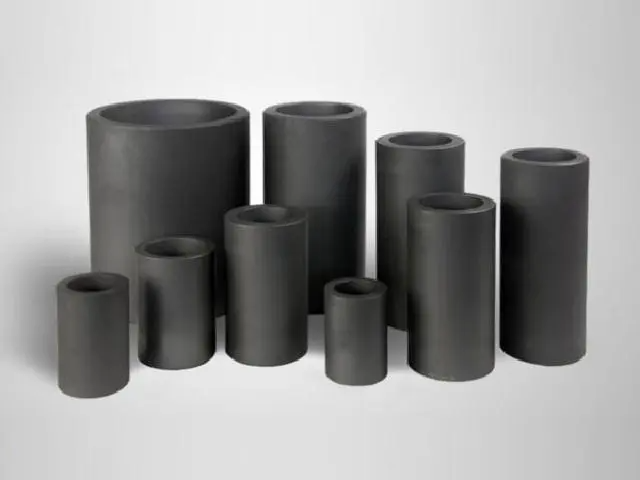Isostatic graphite, also known as isostatically formed graphite, refers to a method where a mixture of raw materials is compressed into rectangular or round blocks in a system called cold isostatic pressing (CIP). Cold isostatic pressing is a material processing method in which changes in pressure of a confined, incompressible fluid are transmitted invariantly to every part of the fluid, including the surface of its container.
Compared to other techniques such as extrusion and vibration forming, CIP technology produces the most isotropic synthetic graphite. Isostatic graphite also typically has the smallest grain size of any synthetic graphite (approximately 20 microns).
Manufacturing process of isostatic graphite
Isostatic pressing is a multi-stage process that allows obtaining extremely uniform blocks with constant physical parameters in every part and point.
Typical properties of isostatic graphite:
• Extremely high heat and chemical resistance
• Excellent thermal shock resistance
• High electrical conductivity
• High thermal conductivity
• Increases strength with increasing temperature
• Easy to process
• Can be produced in very high purity (<5 ppm)
Manufacturing of isostatic graphite
1. Coke
Coke is a component produced in oil refineries by heating hard coal (600-1200°C). The process is carried out in specially designed coke ovens using combustion gases and a limited supply of oxygen. It has a higher calorific value than conventional fossil coal.
2. Crushing
After checking the raw material, it is crushed to a certain particle size. Special machines for grinding the material transfer the very fine coal powder obtained into special bags and classify them according to particle size.
Pitch
This is a by-product of the coking of hard coal, i.e. roasting at 1000-1200°C without air. Pitch is a dense black liquid.
3. Kneading
After the coke grinding process is completed, it is mixed with pitch. Both raw materials are mixed at high temperature so that the coal can melt and combine with the coke particles.
4. Second pulverization
After the mixing process, small carbon balls are formed, which must be ground again to very fine particles.
5. Isostatic pressing
Once fine particles of the required size are prepared, the pressing stage follows. The obtained powder is placed in large molds, the dimensions of which correspond to the final block size. The carbon powder in the mold is exposed to high pressure (more than 150 MPa), which applies the same force and pressure to the particles, arranging them symmetrically and thus evenly distributed. This method allows to obtain the same graphite parameters throughout the mold.
6. Carbonization
The next and longest stage (2-3 months) is baking in a furnace. The isostatically pressed material is placed in a large furnace, where the temperature reaches 1000°C. To avoid any defects or cracks, the temperature in the furnace is constantly controlled. After baking is completed, the block reaches the required hardness.
7. Pitch Impregnation
At this stage, the block can be impregnated with pitch and burned again to reduce its porosity. Impregnation is usually carried out with a pitch with a lower viscosity than the pitch used as a binder. The lower viscosity is required to fill the gaps more accurately.
8. Graphitization
At this stage, the matrix of carbon atoms has been ordered and the transformation process from carbon to graphite is called graphitization. Graphitization is the heating of the produced block to a temperature of about 3000°C. After graphitization, the density, electrical conductivity, thermal conductivity and corrosion resistance are significantly improved, and processing efficiency is also improved.
9. Graphite Material
After graphitization, all properties of the graphite must be checked - including grain size, density, bending and compressive strength.
10. Processing
Once the material is fully prepared and checked, it can be manufactured according to customer documents.
11. Purification
If isostatic graphite is used in semiconductor, single crystal silicon and atomic energy industries, high purity is required, so all impurities must be removed by chemical methods. The typical practice to remove graphite impurities is to place the graphitized product in a halogen gas and heat it to about 2000°C.
12. Surface treatment
Depending on the application of the graphite, its surface can be ground and have a smooth surface.
13. Shipping
After final processing, the finished graphite details are packaged and sent to the customer.
For more information on available sizes, isostatic graphite grades and prices, please feel free to contact us. Our engineers will be happy to advise you on suitable materials and answer all your questions.
Tel: +86-13373889683
WhatsAPP: +86-15957878134
Email: sales01@semi-cera.com
Post time: Sep-14-2024

